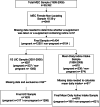The prevalence of using iodine-containing supplements is low among reproductive-age women, NHANES 1999-2006
- PMID: 23616501
- PMCID: PMC3652883
- DOI: 10.3945/jn.112.169326
The prevalence of using iodine-containing supplements is low among reproductive-age women, NHANES 1999-2006
Abstract
During pregnancy, the iodine requirement rises to meet demands for neurological development and fetal growth. If these requirements are not met, irreversible pathological cognitive and behavioral changes to the fetus may ensue. This study estimated the prevalence of iodine-containing dietary supplement (DS) use and intakes of iodine from DSs among pregnant women and nonpregnant women of reproductive age (15-39 y) who were interviewed and examined in NHANES 1999-2006 (n = 6404). Although 77.5% of pregnant women reported taking one or more DSs in the past 30 d, only 22.3% consumed an iodine-containing supplement. Most pregnant women reported using one DS and reported taking this product daily. The vast majority of iodine-containing DSs reported by pregnant women claimed an iodine content of 150 μg iodine/serving on the label. Pregnant women using at least one DS containing iodine had a mean daily iodine intake of 122 μg/d from supplements; the median value was 144 μg/d. Median urinary iodine concentrations (UICs) were similar for pregnant and nonpregnant women in the population aged 15-39 y. The median UIC was 148 μg/L for pregnant women and 133 μg/L for nonpregnant women. The WHO has established a cutoff for insufficient iodine intake at <150 μg/L for pregnant women and <100 mg/L for those who are not pregnant. This suggests that as a population, we may not be meeting adequate intakes of iodine for pregnant women. More research is needed on the iodine intakes of pregnant women and women of reproductive age on their total iodine intake from all sources, not just DSs.
Conflict of interest statement
Author disclosures: J. J. Gahche, R. L. Bailey, L. B. Mirel, and J. T. Dwyer, no conflicts of interest.
Figures

References
-
- Zimmermann MB. Iodine deficiency in pregnancy and the effects of maternal iodine supplementation on the offspring: a review. Am J Clin Nutr. 2009;89:S668–72. - PubMed
-
- Tayie FA, Jourdan K. Hypertension, dietary salt restriction, and iodine deficiency among adults. Am J Hypertens. 2010;23:1095–102. - PubMed
-
- Hollowell JG, Staehling NW, Hannon WH, Flanders DW, Gunter EW, Maberly GF, Braverman LE, Pino S, Miller DT, Garbe PL, et al. Iodine nutrition in the United States. Trends and public health implications: iodine excretion data from National Health and Nutrition Examination Surveys I and III (1971–1974 and 1988–1994). J Clin Endocrinol Metab. 1998;83:3401–8. - PubMed
-
- Caldwell KL, Jones R, Hollowell JG. Urinary iodine concentration: United States National Health and Nutrition Examination Survey 2001–2002. Thyroid. 2005;15:692–9. - PubMed
-
- Caldwell KL, Makhmudov A, Ely E, Jones RL, Wang RY. Iodine status of the U.S. population, National Health and Nutrition Examination Survey, 2005–2006 and 2007–2008. Thyroid. 2011;21:419–27. - PubMed
MeSH terms
Substances
LinkOut - more resources
Full Text Sources
Other Literature Sources
Miscellaneous

